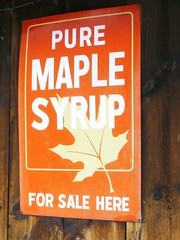Maple Syrup: Lessons in Math, Biology & History
Ratios as a Sweet Treat!
By CISA

Maple syrup sign in Worthington, MA. (Photo credit: Sienna Wildfield)
As one of his first orders of business, CISA’s new Executive Director, Phil Korman, has offered to share a maple syrup-based math lesson that he developed for use in his son’s 4th grade classroom. He’s been doing a variation on this lesson with his son’s class for several years, so it can be adjusted to fit most young age groups.
First he introduces the students to the lesson by talking a little bit about the history of maple syrup and how sap is harvested and turned into syrup. This is a great opportunity to teach your students about early American history, and also to explore the biology of maple trees. Visit the Massachusetts Maple Producers Association website for exhaustive resources on all things maple. Once the students are introduced to the wide world of maple trees, sap, and syrup, Phil leads them through the following math lesson, which includes a syrup tasting as a special treat.
Phil’s lesson on Maple Syrup Math and the ratio of 40 to 1 Facts: It takes 40 pints of tree sap from a sugar maple tree to make one pint of maple syrup. It takes 40 gallons of tree sap to make 1 gallon of maple syrup. Using that information, answer the following questions:
- How many pints of tree sap does a farmer collect to make 10 pints of maple syrup?
- How many gallons of tree sap does a farmer boil to make 1 1/4 gallons of maple syrup?
- If it takes 20 hours of boiling to make 1 gallon of maple syrup, how many hours of boiling did it take to make 1 1/4 gallons of maple syrup?
- Now that you’ve tasted the syrup, do you think all that work was worth it?
The possibilities for using maple syrup as a teaching tool do not end with ratios, of course. Many local sugar houses offer tours to student groups, so this is a great time of year to plan a field trip and visit a working farm, and you can visit CISA’s website to find a sugarhouse near you. It goes without saying, of course, that all of these exciting ideas for incorporating maple sugaring season into your classroom will be most successful if they involve taste tests!
Check out these resources to help you bring your maple dreams to life: the Massachusetts Maple Growers Association and CISA’s online Farm Products Guide.
 Hilltown Families
Hilltown Families 




























